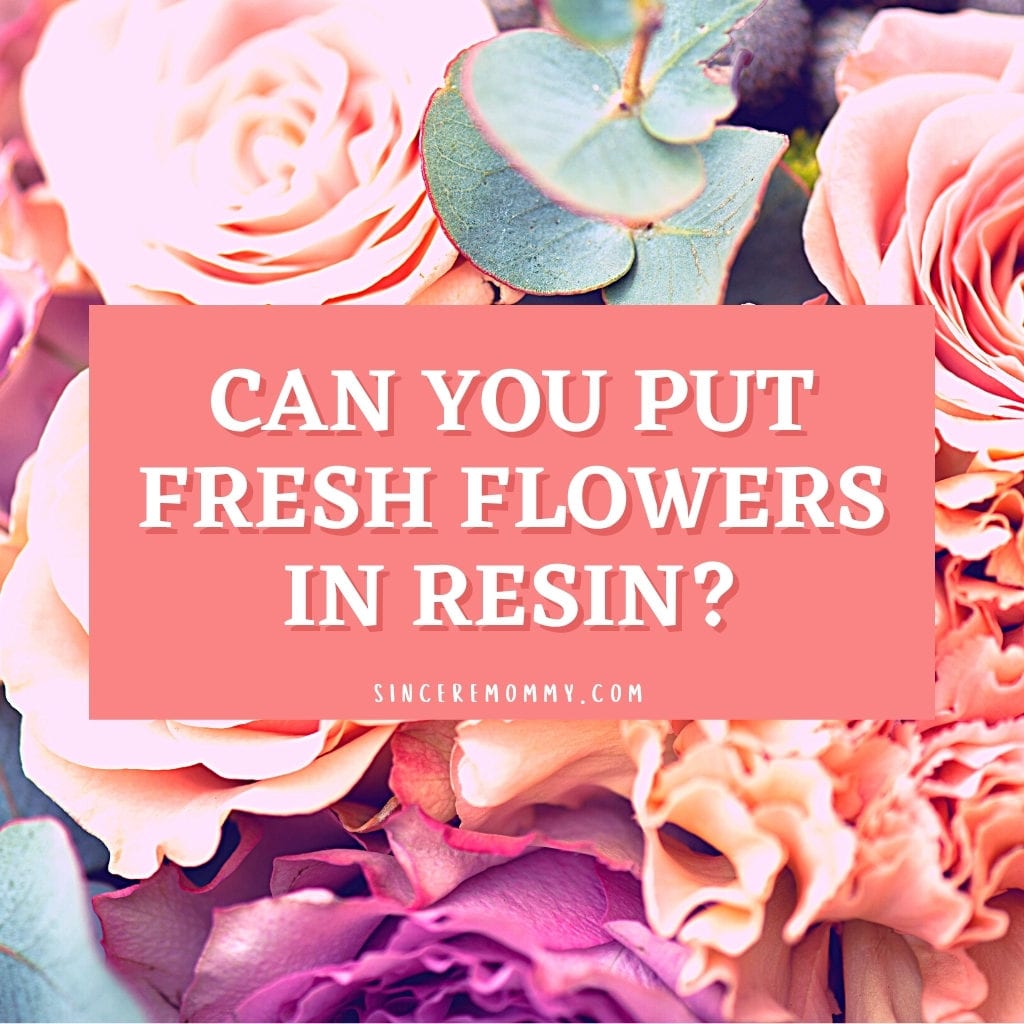Hi readers! Today, I will address a question that I see from time to time. People want to know if you can put fresh flowers in resin. My answer is no. You should not put fresh flowers in resin.
Can it possibly be done? Yes, but the results will most likely not be what you desire.
*As an Amazon Associate, this post contains affiliate links. This means if you click and purchase something through them, I may receive a commission. This is at no extra cost to you.
Table of Contents
It is not recommended
Fresh flowers are beautiful, right? They are vibrant and brightly colored. They look so lovely and full of life, so naturally, you would love to capture that beauty in a resin craft.
You have decided to place a fresh-cut flower directly in resin. The resin cures, but what is the result?
The result is NOT what you’d expect. The initially vibrant and beautiful flower is now brown and yellowed. It looks wilted and dead. Not at all what you wanted to happen.
But why did this happen?
Oxygen
Oxygen is the culprit. When you remove a flower from the stem, the decomposition process will begin shortly after. So essentially you have killed it.
You can prolong the inevitable for a little while with a vase of water. Still, ultimately, your flowers wilt and fall apart, right?
Well when you put fresh flowers in resin, the same thing happens. While the resin has coated the flowers, they still contain oxygen.
Your flowers will release oxygen while the resin is curing. This means it will undergo the same process of decomposition. But, honestly, the chemical reaction of the resin speeds up the process.
The resin heats up as gasses are released from the flower, causing unfortunate results.
Exact reasons why you should not put fresh flowers into resin.
- Color Fading: Fresh flowers can lose their vibrant colors and fade when submerged in resin, especially over time. Resin can cause the colors to leach out, resulting in a dull appearance.
- Wrinkling and Shrinking: Fresh flowers contain moisture, which can cause them to wrinkle and shrink when exposed to resin. This can distort the shape and texture of the flowers, leading to an undesirable outcome in the resin piece.
- Air Bubbles: Air bubbles may form around fresh flowers when they are encapsulated in resin. These bubbles can disrupt the clarity and smoothness of the resin, detracting from the overall aesthetic.
- Mold and Decay: Organic matter like fresh flowers can decompose over time, creating pockets of air and potentially leading to mold growth within the resin. This can compromise the structural integrity of the resin piece and cause unpleasant odors.
- Resin Yellowing: Resin has a tendency to yellow over time, especially when exposed to UV light. When fresh flowers are embedded in resin, they can accelerate the yellowing process, resulting in a less visually appealing outcome.
- Difficulty in Preservation: Fresh flowers are delicate and may not retain their original shape and appearance once submerged in resin. Preserving the natural beauty of flowers in resin requires special techniques such as drying and pressing beforehand.
- Longevity Concerns: Fresh flowers have a limited lifespan, and their beauty may diminish over time even before they are encapsulated in resin. This can affect the overall longevity and aesthetic appeal of the resin piece.
- Preparation Challenges: Fresh flowers need to be properly prepared before being embedded in resin to minimize the risks mentioned above. This process can be time-consuming and may require specialized equipment and techniques.
- Alternative Preservation Methods: There are alternative methods for preserving the beauty of flowers, such as pressing, drying, or using silk or dried flowers, which may yield better results when combined with resin.
- Aesthetic Considerations: Depending on the type of flowers used and their condition, the final appearance of the resin piece may not meet expectations. Factors such as transparency, clarity, and overall composition can be affected by the presence of fresh flowers.
How can I avoid losing the color of my flowers?
Now you are wondering if I can’t put them in fresh, how else can I keep them?
The easiest solution is to dry them or press them. Both methods involve removing moisture from the flowers.
Of course, your flower will not look 100% like when you plucked it from the stem, but it will be much closer than if you throw it straight into the resin.
I will explain the two ways I like to dry my flowers.
Method One: Hanging To Dry
This method works best for flowers like roses and long-stemmed flowers like lavender.
Once the flowers are cut, you should gently but securely tie your stems together with twine.
Find a dark room or closet to hang them in upside down. This could take up to a few weeks to complete, and you may experience some petal loss.
Your flowers will be highly delicate once dried. However, they retain a bit of color.
Avoiding sunlight will help prevent extra color loss and mold growth.
Method Two: Pressing (My Preferred Way)
Can you put fresh flowers in resin for beautiful results? Not quite, but here’s the next best thing.
I highly recommend pressing your flowers. This is simple, effective, and yields incredible results every time.
I like to put the flower face down on a coffee filter and sandwich it with others. Then I place the coffee filters inside a heavy book with many pages.
I close the book on the coffee filters and sit something heavy on top of the book. I check the flowers every few days to ensure they aren’t moldy.
After about a week, my flowers are typically perfectly dried.
Faster Flower Pressing
If pressing flowers takes too long, as many people do, then I have an excellent solution for you.
It is called a Microfleur, and it honestly is fantastic. It takes flower pressing and cuts it down from weeks to minutes.
Yes, it is possible, and if you get impatient like I do sometimes, you will love this.
I have written a review on the Microfleur if you’d like to check it out.
Can I Put Other Organic Material In Resin?
Again, yes, it is possible. You can coat things with resin, such as wood, leaves, or even insects.
As with flowers, I never recommend using live, fresh specimens. For one, putting a live insect into resin is cruel on so many levels. Even if you hate bugs, it is sad to think about.
Suppose you absolutely must put an insect in resin. In that case, I suggest using only one that died naturally that you find outdoors. The most typical insects people like to preserve are honey bees and bumble bees.
Maybe you have a pet spider or scorpion (Eek!) that you’d like to memorialize when it passes.
Either way you will want to sit it in the sun to dry for a few days up to a week before preserving it.
Oxygen Creates Bubbles
This sounds creepy but the truth is that things like wood and leaves still can “breathe” after they have been coated in resin.
Remember how I mentioned the release of oxygen from fresh flowers? The same sort of principle applies here.
Materials like wood will contain air pockets and release oxygen once coated with resin. Unfortunately, this can cause bubbles in your resin, ultimately creating holes in your project.
For this reason, you should always try to treat or coat wood before you cast it in resin.
In short, sealed wood works best because it cannot release oxygen like untreated wood.
Many Ways To Put Flowers In Resin
As you can see, there are multiple ways to put flowers in resin to make something beautiful. Try experimenting with some dried flowers from your garden or wild florals.
Another great thing to try is to use faux flowers! Want a perfectly colored flower that doesn’t wilt, rot, or change shape?
Then faux flowers are one of your best options. Some fake flowers look highly realistic, and you may prefer them over natural flowers.
There are tons of marvelous resin molds to try to make your resin crafts genuinely unique.
How Can I Learn More About Resin?
I’ve got you completely covered when it comes to resin. I highly recommend my post, which includes 9 tips for resin beginners.
If you are curious to learn more about resin, you can check out my post about resin!
In addition, if you are looking for resin-related products such as molds, colorants, equipment, and more, you can see my complete product recommendation list on Amazon.
Check Out Tons Of Resin Supplies Right Now On Amazon.

